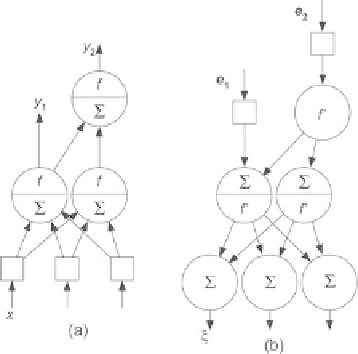Information Technology Reference
In-Depth Information
Fig. 4.20.
Adjoint of a layered feedforward network (
a
) Original network,
f
stands
for the transition operator through the nonlinear activation function (
b
) adjoint
network, notation
f
stands for the linear product by the derivative of function
f
taken at the current point of the original network
•
backpropagation of the error through the adjoint unfolded network for
k
=1to
p
,
n
+1
=
g
∗
(
ε
n
+1
,
ξ
n
+1
,
w
)
.
Figure 4.20 illustrates the construction of the adjoint network in a simple
case.
We showed on picture (a) a layered network with three inputs, a first
layer with a hidden neuron and an output neuron and a second layer with a
single output neuron. Thus, the network performs a nonlinear application of
R
3
into R
2
. On picture (b), the adjoint network performs a linear mapping
of R
2
into R
3
. The inputs of the adjoint network are the error signals that
are associated to the original network outputs. The mathematical definition
is simple: the adjoint of the nonlinear application
y
=
g
(
x
) is the linear
application
ξ
=[
Dg
(
x
)]
T
ε
,where[
Dg
(
x
)]
T
is the transposed matrix of the
Jacobian matrix of
g
at
x
, i.e., the matrix of the partial derivatives. It is
just a graphical representation of the backpropagation algorithm, which is
frequently used to compute the gradient of the cost function with respect to
the parameters.
Once the error signals of the adjoint network are computed, the compu-
tation of the quadratic error gradient is achieved through implementing the
classical backpropagation rule. However, one has to consider that the network
is an unfolded network. Actually, the network has been duplicated
p
times
where
p
is the width of the time window. Therefore, the numerical value of
one connection weight is shared by several connections that have different
locations in the unfolded network.
ξ
k−
1

Search WWH ::

Custom Search